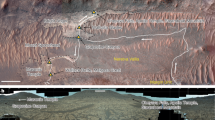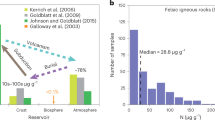Abstract
ONLY detailed sampling of early weathering stages combined with suitable analytical techniques can reveal the presence of gibbsite as a primary weathering product in certain weathering crusts of acid igneous rocks. It is therefore instructive to examine the findings of some previous workers in relation to the methods they used.
This is a preview of subscription content, access via your institution
Access options
Subscribe to this journal
Receive 51 print issues and online access
$199.00 per year
only $3.90 per issue
Buy this article
- Purchase on SpringerLink
- Instant access to full article PDF
Prices may be subject to local taxes which are calculated during checkout
Similar content being viewed by others
References
Harrison, J. B., The Katamorphism of Igneous Rocks under Humid Tropical Conditions (Imperial Bureau of Soil Science, 1933).
Humbert, R. P., Soil Sci., 65, 281 (1948).
Leneuf, N., L'altération des Granites Calco-Alcalins et des Granodiorites en Cote d'Ivoire Forestière et les Sols qui en sont Dérivés (Office de la Recherche Scientifique et Technique Outre-Mer, Paris, 1959).
Author information
Authors and Affiliations
Rights and permissions
About this article
Cite this article
WATSON, J. Formation of Gibbsite as a Primary Weathering Product of Acid Igneous Rocks. Nature 196, 1123–1124 (1962). https://doi.org/10.1038/1961123a0
Issue date:
DOI: https://doi.org/10.1038/1961123a0



